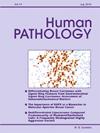Clinicopathologic and molecular characterization of primitive neuroectodermal tumors (PNET) in the female genital tract: a retrospective study of 8 cases
IF 2.7
2区 医学
Q2 PATHOLOGY
引用次数: 0
Abstract
Aims
This study aimed to investigate the molecular alterations in primitive neuroectodermal tumors (PNET) of the female genital tract.
Methods
We retrospectively analyzed the clinicopathologic and immunohistochemical features of 8 gynecologic PNET cases (3 cervical, 1 vaginal, and 4 ovarian). Fluorescence in situ hybridization and targeted next-generation sequencing (NGS) were performed to identify molecular alterations in these tumors.
Results
The cohort included 5 FIGO stage I, 1 stage III, and 2 stage IV tumors. Two patients with stage IV disease died at 8 and 12 months. The cervical/vaginal tumors consisted of small round blue cells arranged in sheets, with EWSR1 rearrangements and concurrent diffuse expression of membranous CD99 and nuclear FLI1. The ovarian tumors displayed diverse morphologic features resembling central nervous system (CNS) tumors, including embryonal tumor with multilayered rosettes (case 5), medulloblastoma (case 6), glioblastoma (case 7), and ependymoma (case 8). Three ovarian tumors were associated with teratomas. None of the ovarian tumors exhibited EWSR1 rearrangements or i(12p)/12p overrepresentation. NGS identified an EWSR1::exon11∼FLI1::exon6 fusion in one cervical PNET, with no additional molecular alterations. In contrast, three ovarian tumors lacked common genetic changes seen in CNS tumors but harbored several significant variants, including NTRK2 exon11 c.1019C > T (p.T340 M) (case 6), INPP4B exon23 c.2221G > A (p.V741 M) (case 7), and FANCG exon7 c.882_883insA (p.D295Rfs∗14) with MET 7q31 polysomy (case 8).
Conclusions
Our findings confirm that cervical/vaginal and ovarian PNET represent two distinct tumor types. Ovarian PNET have different pathogenetic pathways from their CNS and testicular counterparts most likely.

求助全文
约1分钟内获得全文
求助全文
来源期刊

Human pathology
医学-病理学
CiteScore
5.30
自引率
6.10%
发文量
206
审稿时长
21 days
期刊介绍:
Human Pathology is designed to bring information of clinicopathologic significance to human disease to the laboratory and clinical physician. It presents information drawn from morphologic and clinical laboratory studies with direct relevance to the understanding of human diseases. Papers published concern morphologic and clinicopathologic observations, reviews of diseases, analyses of problems in pathology, significant collections of case material and advances in concepts or techniques of value in the analysis and diagnosis of disease. Theoretical and experimental pathology and molecular biology pertinent to human disease are included. This critical journal is well illustrated with exceptional reproductions of photomicrographs and microscopic anatomy.
 求助内容:
求助内容: 应助结果提醒方式:
应助结果提醒方式:


